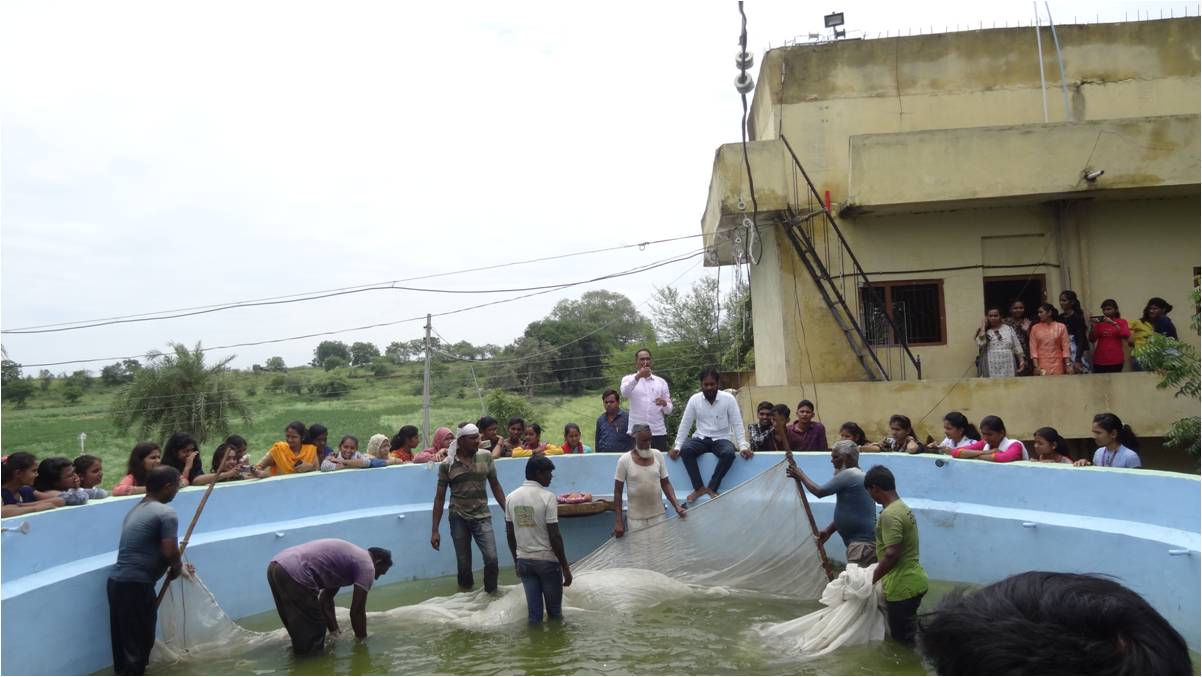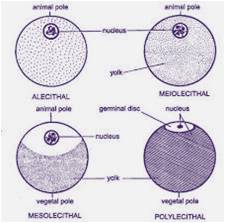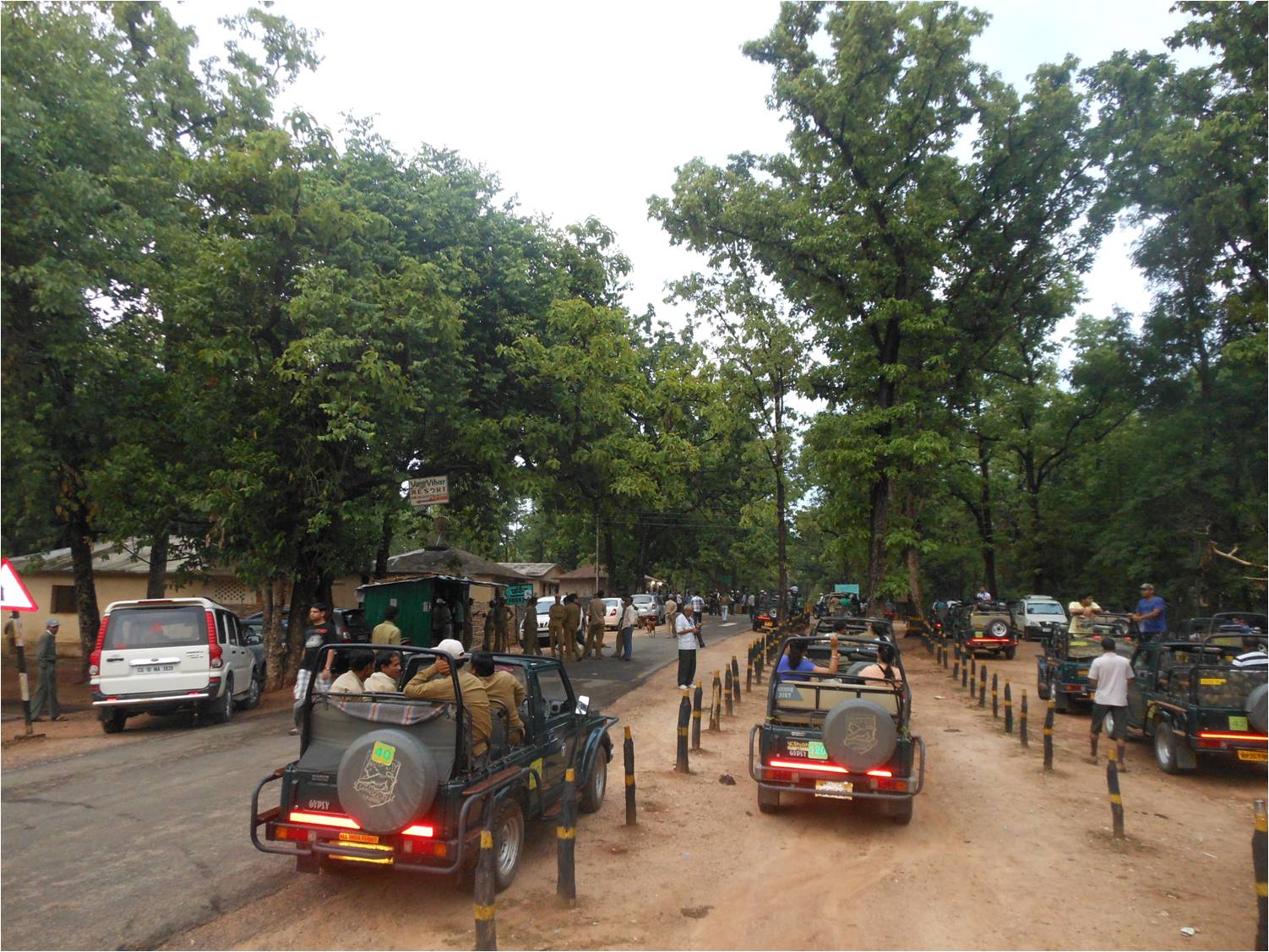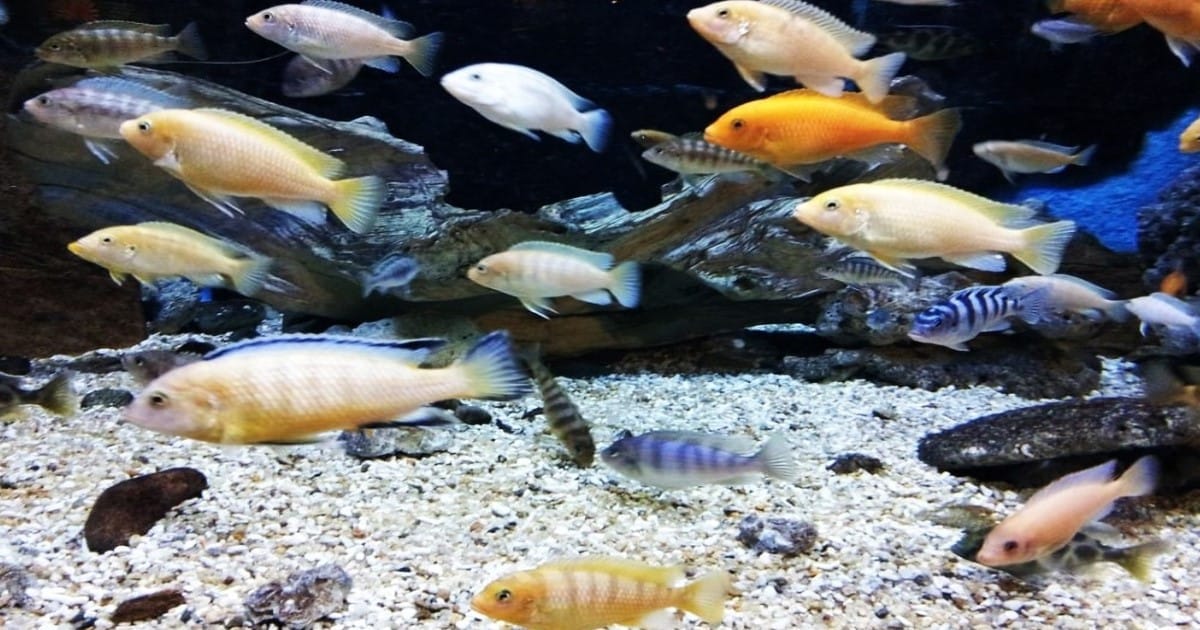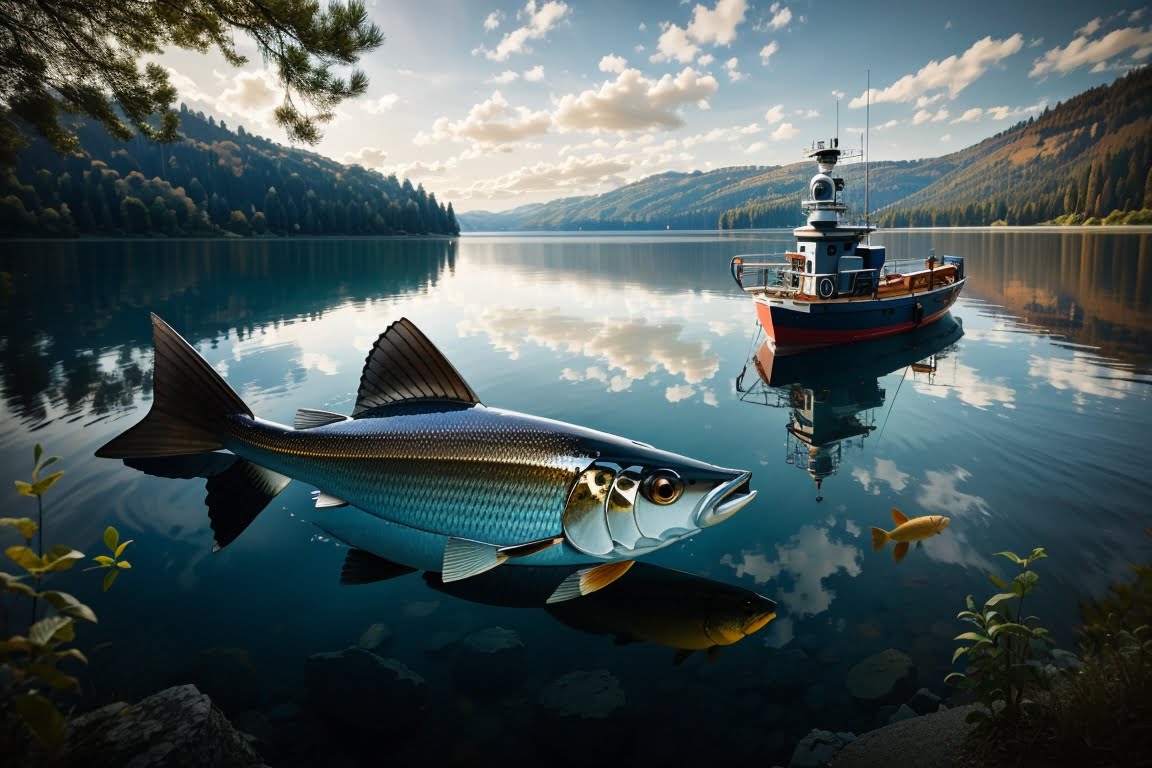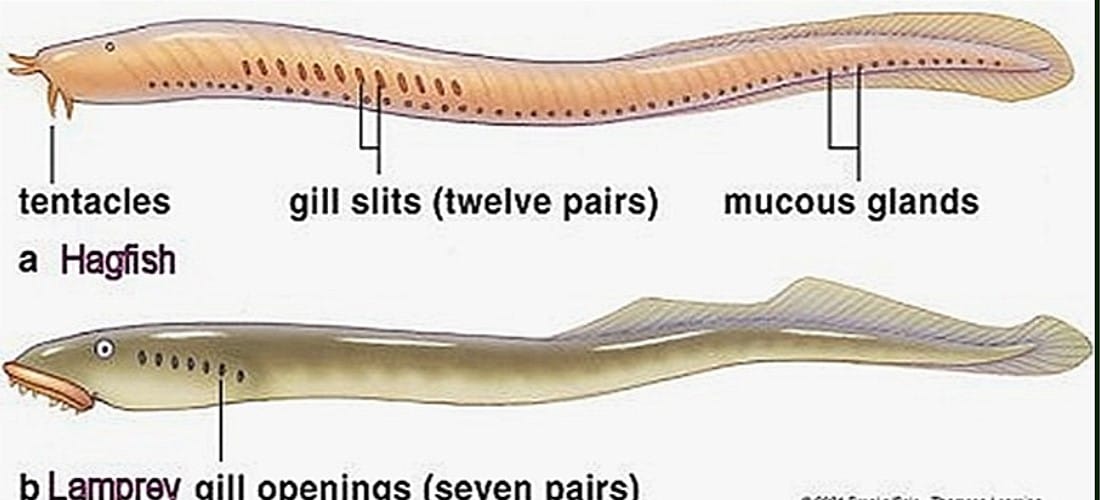Coelomate Animals: Here we can study the museum specimens of celomate animals their classification and characteristic.
Coelomate animals are those that possess a true coelom, a fluid-filled body cavity completely lined by mesodermal tissue. This group includes a wide variety of animals, from simple invertebrates (Mollusks, Annelids, Arthropods and Echniodermata) to complex vertebrate (Chordata) animals.
Coelomate Animals- Museum Specimens
1. Chiton or Ischnochiton
Classification :
Phylum …………. Mollusca
Class …………….. Amphineura
Order …………… Polyplacophora
Genus …………… Chiton (Sea mouse)
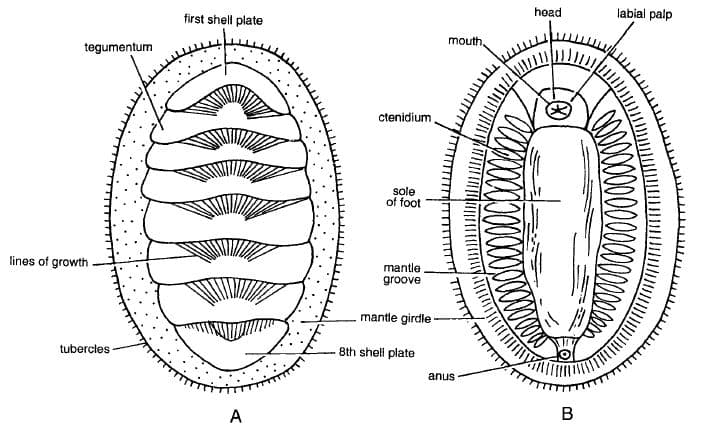
Characters:
- Chitons are found in marine shallow waters, few species live in deep sea.
- Commonly called as sea mouse, measuring about 1 to 5 cms.
- Body is elliptical, bilaterally symmetrical and dorsoventrally flattened with small, head, large flat foot and dorsal mantle roof.
- Head contains ventral mouth and labial palps.
- Eyes and tentacles are absent. Mouth and anus are opposite ends.
- Dorsal side of mantle contains a linear series of 8-calcareous overlapping plates marked with lines of growth. ‘Coelomate Animals: Museum Specimens’
- Sometimes Chiton is eaten by man. The foot is called as sea beal.
2. Unio
Classification :
Phylum…………. Mollusca
Class ……………… Pelecypoda
Order ……………. Eulamellibranchiata
Genus ……………. Unio
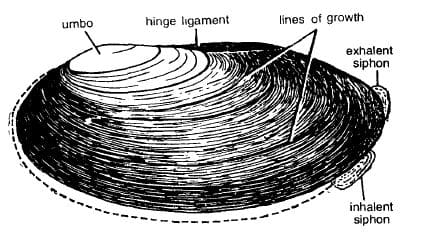
Characters:
- Unio found in ponds, lakes, rivers and streams.
- Commonly called as fresh water mussel or clam.
- Body is dark brown, bilaterally symmetrical and flattened and measuring 5 to 10 cm in length.
- Animal is completely enclosed in equal bivalve shells.
- Two valves are united together along the dorsal side in a straight hinge-line by hinge-ligament.
- Anteriorly, in front of the hinge, there is a whitish, knob-like swelling on each valve, called as umbo.
- Posteriorly, on lateral margins there are two openings; smaller one is exhalent siphon, while the larger one is inhalent siphon.
- Sexes are separate but the male and female shells are alike.
3. Nereis
Classification :
Phylum …………. Annelida
Class …………….. Polychaeta
Order ……………. Errantia
Genus…………….. Nereis
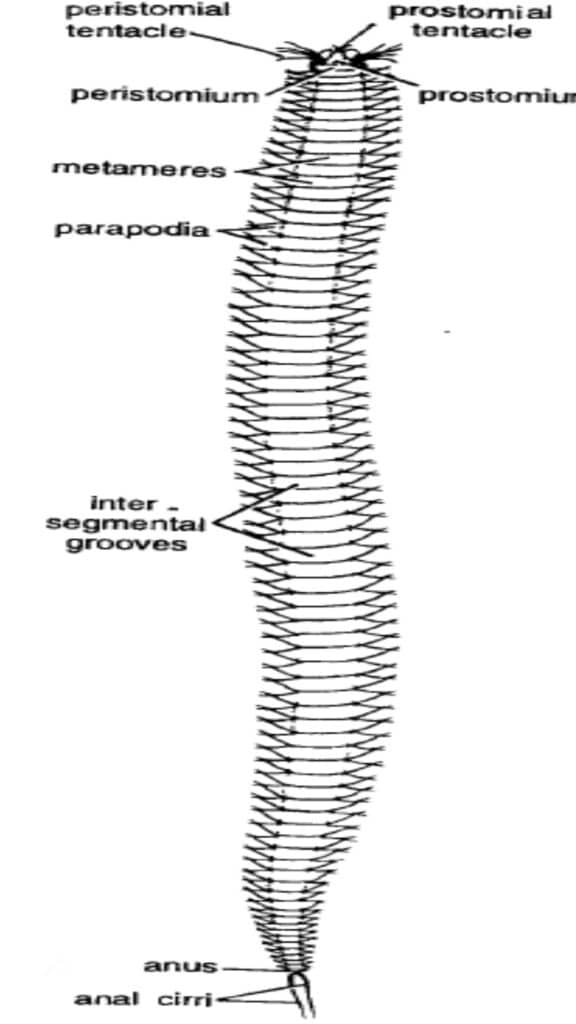
Characters:
- Nereis is found in marine water crawling type, living in temporary burrows in sand, 200 meters deep.
- Commonly called as Rag worm or Clam worm and is the simplest annelid.
- Examination of preserved specimen shows cylindrical and elongated body form which is divided into similar metameres or segments about 200 in number.
- First few segments fuse to form head which is composed of (i) prostomium or preoral lobe, which carries prostomial tentacles, palps and ocelli; and (ii) peristomium (2 segments fused), which carries antero-laterally 4 pairs of peristomial tentacles.
- Mouth is found on the anterior surface of the peristomium.
- Body has metameres segments, except head and anal segment, contain each pair of locomotory parapodia.
- Parapodia also serve as respiratory and circulatory functions. Each parapodium is composed of dorsal notopodium and ventral neuropodium.
- Anal segment contains a pair or anal cirri.
4. Chaetopterus
Classification :
Phylum …………. Annelida
Class …………….. Polychaeta
Order …………… Tubicola
Genus ……………. Chaetopterus
Characters:

- Chaetopterus is a tubicolous, marine and bioluminescent annelid which lives permanently in a U-tube.
- Commonly called as paddel worm having greatly modified segments.
- Tube is opaque, measuring approximately 50 cm long and about 1 cm in diameter.
- Body is white, 30 cm long and divided into anterior, middle and posterior regions.
- Parapodia are variously modified as for water pumping fans, sucking discs or food ball organs.
- Anterior region comprises of 15 to 20 segments, having a funnel-shaped mouth.
- Middle region has fused segments. The notopodia of segments 14 to 16 are fused in mid line to form three fans. Notopodia are fused to form suckers.
- Posterior region is longer with a pair of parapodia in each segment, about 11 to 30 in number.
5. Eupagurus (Hermit-crab)
Classification :
Phylum …………. Arthropoda
Class……………… Crustacea
Sub-class ………. Malacostraca
Order …………… Decapoda
Genus…………… Eupagurus (The Hermit-crab)

Characters:
- Eupagurus leads a commensal life. It adjust in the coils of molluscan shells.
- Commonly known as Hermit-crab.
- Body is reduced and asymmetrical but shows usual divisions into head, thorax and abdomen.
- Head contains antennules, antennae and stalked eyes. Thoracic appendages protrude through the opening of the shell. First thoracic leg is chelate and rest reduced.
- Abdominal appendages of the right side absent while those of left side reduced. Sixth left abdominal appendages (uropod) adapted for holding the body in hollow objects.
- Seventh and eighth thoracic appendages are reduced and remain inside the mollusc shell.
- Uropods are hooked and notched in the shell.
6. Palamnaeus (Scorpion)
Classification :
Phylum ………….. Arthropoda
Class ……………… Arachnida
Order ……………. Scorpionida
Genus ……………..Palamnaeus (Scorpion)
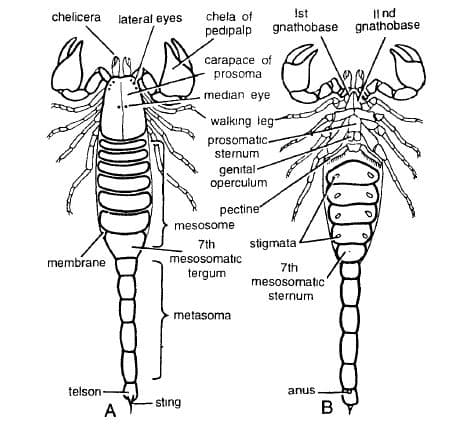
Characters:
- Palamnaeus is a nocturnal arthropod, found in sand, crevices and under stones and in bark of dead trees.
- Commonly called as scorpion.
- Body is elongated, segmented and differentiated into anterior prosoma and posterior opisthosoma.
- Opisthosoma is sub-divided into a broad anterior mesosoma and a narrow posterior metasoma.
- Prosoma is covered dorsally by a carapace and its appendages are a pair of small chelate chelicerae, a pair of large chelate pedipalps, 4 pairs of walking legs and several ocelli.
- Body is encased in chitinous covering. The dorsal side covering is called as tergum, side one pleuron and ventral one sternum.
- Mesosoma is composed of 7 broad segments and metasoma of 5 narrow segments.
- Last metasomatic segment is telson containing a sting.
- Just beneath chelicerae there are I and II gnathobases.
- Sexes are separate but without sexual dimorphism. Viviparous.
7. Asterias (Sea Star or Starfish)
Classification :
Phylum ………….. Echinodermata
Sub-phylum ……. Eleutherozoa
Class ……………… Asteroidea
Order …………….. Forcipulata
Genus ……………. .Asterias
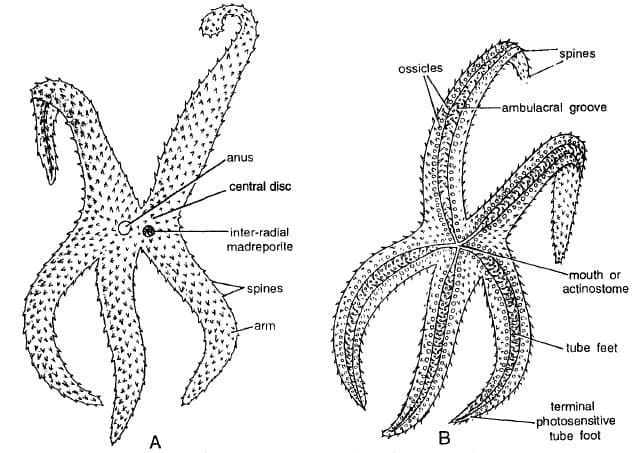
Characters:
- Asterias is a marine form, found below 200 fathoms on most of the eastern seashore
- Commonly called as starfish or sea star.
- Body is radially symmetrical, star-shaped and pentagonal.
- Body or central disc of the animal is distinguished into downwardly directed oral (mouth) and upwardly directed aboral surfaces.
- Central disc is continued into 5 arms.
- Aboral surface is pink and contains conical spines. The finger-like semi-transparent branchiae and pedicellariae are also present on aboral surface.
- Oral surface contains central actinostome or mouth, from which five ambulacral grooves extend, one in each arm.
- The open ambulacral groove accommodates a large number of podia or tube feet. Water vascular system is well developed.
- Pedicellariae are usually present and may be of more than one kind.
- Sexes are separate. Fertilization is external. The larva is typically a bipinnaria developing into a brachiolaria before metamorphosis into adult.
8. Pentaceros
Classification :
Phylum …………… Echinodermata
Sub-phylum ……. Eleutherozoa
Class ……………… Asteroidea
Order …………..… Phanerozonia
Genus ……………. Pentaceros (Starfish)
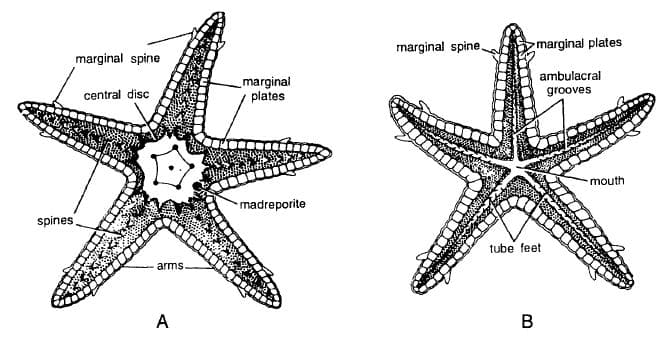
Characters:
- Pentaceros is the most common eleutherozoan echinoderm found in sea from shallow water to 1,000 fathoms.
- Commonly called as sea pentagon or starfish.
- Body is enclosed in a tough, hard and leathery integument containing several ossicles.
- Central disc and the arms are fused together. Arms contain extension of gonad, coelom and the gut.
- Body is differentiated into oral and aboral surfaces.
- Aboral surface is brown and convex, containing rows of definitely arranged spines.
- There is a rounded sieve plate or madreporite plate in one of the inter-radii. It forms the first part of the water vascular system which is well developed.
- Oral surface is concave, dark brown, having a centrally-placed mouth or actinostome.
- Ambulacral groove contain double rows of locomotory organs of tube foot.
- Sexes are separate. Development indirect which includes bipinnaria larva.
9. Balanoglossus
Classification :
Phylum ……………. Hemichordata
Class ……………….. Enteropneusta
Genus ……………….Balanoglossus (Acorn Worm)
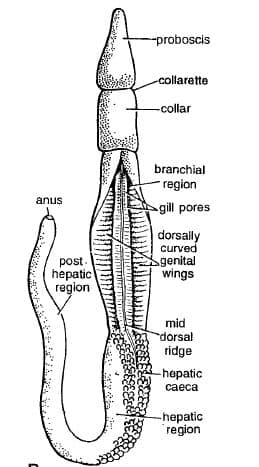
Characters:
- It is a marine animal. adapted for burrowing life in the sandy bottom.
- Balanoglossus is commonly called as ‘Acorn worm.’ It lives in a V-shaped burrow and at one opening of burrow fecal castings may be seen. U-tube burrow at other end has opening for anterior end and also another additional opening.
- It measures 10 cm to 2.5 meters, depending on the species.
- It is bilaterally symmetrical, triploblastic deuterostome with worm-shaped body divisible into three regions-anterior proboscis or prosoma, middle co!lar or mesosoma and posterior trunk or metasoma.
- Proboscis is conical, collar is funnel like, while trunk is cylindrical.
- Proboscis contains heart vesicle, central sinus and buccal diverticulum.
- Collar contains the mouth and colla. coelom which opens by a pair of collar pores on dorsal surface.
- Trunk region contains most of the internal organs, such as pharynx, gonads or hepatic region.
- Alimentation is complete and circulatory system usually contains contractile sac of heart.
- Sexual dimorphism. Fertilization external and development includes tornaria larva. It possesses power of regeneration. ‘Coelomate Animals: Museum Specimens’

